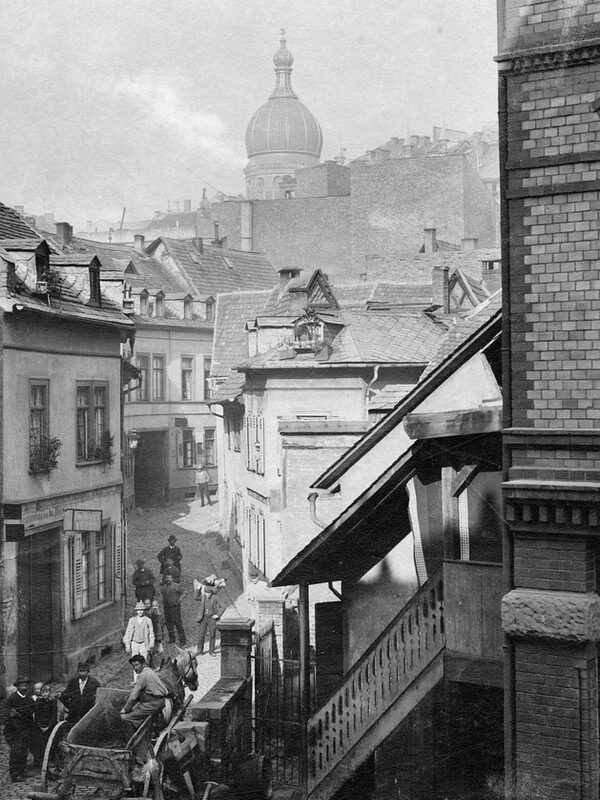Old town
The core of Wiesbaden's old town is the area that has been called "Flecken" since the late Middle Ages and whose center was the old Mauritius Church. The other two medieval districts of the city were the so-called Sauerland with the Kochbrunnen as the center of the Quellenviertel and the Burgstadt with the Marktbrunnen at its center. All three areas, the town and the castle district south of the Heidenmauer and the Sauerland north of it, were fortified with town walls over the centuries.
Today, the old town is defined as the area stretching roughly from the market square in the east to Schwalbacher Straße in the west, and from Rheinstraße in the south to Webergasse in the north. The main axes of the old town are Kirchgasse with Mauritiusplatz, Langgasse and Wagemannstrasse and Grabenstrasse. The latter two streets lead in the shape of a ship's bow to the Goldgasse coming from the Langgasse, which is why the heart of the old town is also known as the little ship.
Wiesbaden was actually unsuitable for human settlement because it had no freshwater springs and, particularly in the east, consisted largely of swampy terrain unsuitable for building. The healing springs in the Sauerland were also salty and unsuitable as a basis for a supply of fresh water.
The village, which was located between the Heidenberg (Römerberg/Schulberg) and the marshland to the east of Neugasse and Grabenstraße, was supplied with water exclusively from the Kesselbach stream. This was called Dendelbach in the Middle Ages. The street on Michelsberg was called "uff de Bach" because this is where the stream flowed down into the village and supplied the drinking water. It powered the Pfaffenmühle mill on Michelsberg and served both the brewery, which stood on the corner of Hochstättenstraße from 1550-1819, and the properties on Metzgergasse, today's Wagemannstraße. In Goldgasse it merged with the Rambach; both then powered the mills in Mühlgasse. It was not until 1820 that the construction of a water pipeline from the Kisselborn to the Platte was started.
In addition to the Mauritius Church, which dates back to a Carolingian building from 780/790, the large courtyards of the nobility and monasteries were characteristic of the medieval town in the area of the spot. They identify Wiesbaden as an agricultural center and location of medieval power. It was evidently the center of the so-called Königssondergaus as early as the 9th century. In the Saalgasse area, on the rock behind the Sauerland, there was probably a royal court with a "Saal", first attested in 1114.
The fact that the town has had a town hall since the 15th century is evidenced by the name "Stadtgericht auf dem Rathaus", also known as the "Hütte", which has been used since 1438. In the vernacular, people spoke of the "Schießhütte" (shooting hut), as the courtyard, which bordered the churchyard wall of Mauritius Church, was used for shooting practice by crossbowmen. The property was located in the area of the former "Zum Einhorn" inn on Marktstraße. With the construction of the Renaissance town hall in 1609/1610, today's old town hall, Wiesbaden's center of gravity shifted to the castle town east of Grabenstraße.
The merging of the three areas - Flecken, Burgbezirk and Sauerland - is the product of historical development. The immediate proximity of Flecken and the area around the castle played a special role in this. Today, their connection is so natural that the concept of the old town has been extended to the current market square. The market fountain formed the center of the castle town. This was the only freshwater fountain in the district belonging to the castle. The nucleus of today's castle area is a tower castle, which was built on piles and wooden grids in the well-defended swamp. In the 10th century, it served as the seat of power for Eberhard of Franconia, the first documented count of the Königssondergau.
Wiesbaden, elevated to imperial city status in 1232, was caught up in the conflict between King Conrad IV and the Archbishop of Mainz, Siegried III von Eppstein, in the course of which the city was destroyed and lost its importance. Adolf, Count of Nassau and German King since 1292, preferred Idstein and Weilburg as residences. His son, Count Gerlach I, rebuilt the castle from 1305. The Nassau Wiesbaden began with him. The court was held here, but was mostly governed from Idstein. It was not until 1701 that Georg August Samuel Prince of Nassau-Idstein had Biebrich Palace built. Charles Prince of Nassau-Usingen elevated Biebrich Castle to a residence in 1744. The "Feste Wiesbaden, Burg und Stadt" lived on in the clock tower, the upper gate of the castle town, until 1873. The lower gate stood where Mauergasse meets Marktstrasse. The long alley (today Langgasse) was the connecting element between all three parts of the town.
Today, the townscape of the old town is characterized by historicist buildings and mostly modern or modernized buildings. In the core area, only a few buildings from before 1900 have been preserved in their original form, especially as six devastating fires between 1547 and 1586 caused widespread destruction.
These buildings include the old town hall, the Cetto House, the Schenck House and the craftsman's house at Nerostrasse 24 (around 1810), as well as the buildings erected in the Nassau and Wilhelmine periods. In the old town area, these include the Erbprinzenpalais, the buildings on Luisenplatz, the city palace, the ministerial building, St. Boniface's Church, the market church, the building of the Wiesbaden Casino Society and the new town hall.
Literature
Renkhoff, Otto: Wiesbaden im Mittelalter, Wiesbaden 1980 (Geschichte der Stadt Wiesbaden 2).
Old Wiesbaden in pictures by Hans Bossung. Ed.: Lions-Club Wiesbaden - Drei Lilien in cooperation with the Wiesbaden Casino Society, Wiesbaden 1999.
Kiesow, Gottfried: Architectural Guide Wiesbaden. The City of Historicism, Bonn 2006 [pp. 96-108].
